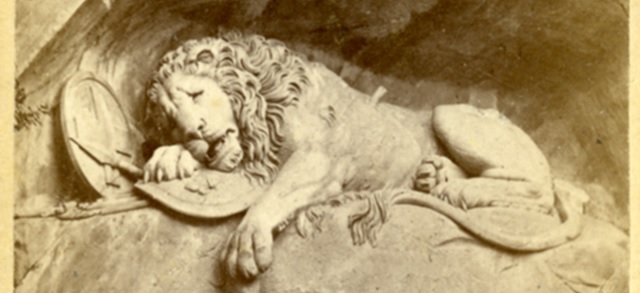
Monuments Class Projects
Preview

Identifier
13a
Medium
photograph, carte-de-viste
Keywords
Pompey’s Pillar; Diocletian’s Column; Alexandria, Egypt; Roman Empire, Alexandria 298 CE; Diocletian, Emperor; cartes-de-visite (card photograph); Pompey; Classical architecture; Corinthian Capital; Greco-Roman Architecture
Physical Dimensions
103mm x 65mm
Date of Publication
18uu
Name of Monument
Pompey's Pillar
Date of Creation of Monument
298
Date of Completion or Dedication of Monument
302
City of Monument
Alexandria
Location within City
Southwest
State/Province of Monument
Alexandria Governate
Country of Monument
Egypt
Description
A carte-de-visite historical photograph of Pompey’s Pillar, a Roman triumphal column in Alexandria Egypt. The column was set up in honor of the Roman Emperor Diocletian between 298-302 AD after he besieged the city for eight months and spared what remained of it from looting. During the Middle Ages, European Crusaders misidentified Diocletian’s Column as Pompey’s Pillar, believing it to be for Pompey who was assassinated in Egypt after fleeing from Julius Caesar’s forces. They believed his ashes sat in a pot at the top.
School of Art/Architecture
Classical
Digital Date
1-26-2022
Copyright
Original physical carte-de-viste is in the public domain. Digital copy scanned by Rod Library, ©2022 Rod Library, University of Northern Iowa
Rights Advisory
Original physical carte-de-viste is in the public domain; U.S. and International copyright laws protect this digital object. Commercial use of this digital object is not permitted without prior permission of the copyright holder.
Creative Commons License

This work is licensed under a Creative Commons Attribution-NonCommercial 4.0 International License
File Format
image/jpeg



Comments
Background
Rising above the plateau containing the remains of the Temple of Serapis, Pompey’s Pillar sits in the south-west portion of Alexandria. Its name would lead one to believe that the pillar commemorates Gnaeus Pompeius Magnus, or Pompey the Great, one of the members of Rome’s First Triumvirate, with Gaius Julius Caesar, and Licinius Crassus. Closer research into the pillar indicates that it was not erected to the assassinated general, but for the Roman Emperor Gaius Aurelus Valerius Diocletianus, or Diocletian. So how did a column dedicated to Diocletian end up being remembered as a monument to the slain Pompey?
Integral to the Greeks, Egyptians, and Romans in turn, Alexandria was an important civic center in the Eastern part of the empire. After the fall and conquest of the Ptolemaic Dynasty in 30 CE, a large amount of Rome’s grain came through the city and from surrounding Egyptian territory under Roman control. It also served as a main trading center with the empires to the East. In 297 CE, irate at their Roman rulers, Greeks, Egyptians, and Arabs living in the city joined together under the leadership of Lucius Domitius Domitianus Augustus and rebelled. He died before the end of the rebellion and was replaced by Aurelius Achilleus, after he passed away.
By 298, Diocletian had surrounded Achilleus’ forces in the city of Alexandria and began a siege. After eight months of suffering, the citizens left in the city capitulated. This began a looting spree as fires broke out in the conquered city. Legend holds that the destruction ended as when Diocletian entered the city with his troops and his horse stumbled. Seeing this as a sign from the gods to preserve the city, he ordered the cessation of his troops' destruction of the city. The leaders of the rebellion were executed, including Achilleus. Diocletian had grain meant for Rome diverted to the city as well as exempting the people from paying taxes for a time. In gratitude, the officials of the city, led by the governor of Aegyptus, Aelius Publius, erected the column to proclaim two messages: one as a tribute to the Emperor who spared the city, but also to signify the Roman’s dominance of Alexandria. This 258.5 metric ton monolithic pillar is capped with a Corinthian style capital. Originally, a porphyry statue of the Emperor Diocletian stood on top, towering over the Egyptian landscape. The remaining inscription reads:”Publius, governor of Egypt, [set this up to honor] the most revered emperor, the guardian-god of Alexandria, Dioceltian the invincible (?...).” It rises about 30 meters above the Temple of Serapis site, a holy site during the days of the Ptolemaic rule of Egypt which had been rebuilt as a Roman temple after two devastating fires destroyed the site. It sits on a plateau south-west of the city, but could be viewed by the surrounding area.
Legends state that as Christian Crusaders of Europe entered the Middle East during the Crusades, some came across the column in Alexandria. It was mostly intact though the porphyry statue that used to crown the top had disappeared. Reading the inscription, which was in Greek, they believed that the name mentioned was of Pompey Magnus. During the fall of the Republic, Rome had fallen into a civil war between Julius Caesar and Pompey Magnus, the two surviving members of the First Triumvirate. After being bested in battle, Pompey fled to Egypt, seeking refuge there but instead was assassinated upon his arrival. The Crusaders believed that the ashes of Pompey sat on top in a “pot” which was actually the remains of the statue’s base.
It is more likely that European travelers, rather than actual crusaders, bestowed on the column. Once the name Pompey’s Pillar was given, it stuck, with many remaining unaware of the true history behind it. Though research done by archaeologists and ancient historians have since established that this was dedicated to Diocletian, the romantic allure of the assassinated general outweighs the pull of the later history. Due to Pompey’s fame and fate in Egypt, it is no wonder why people still refer to the column as Pompey’s Pillar.
----------------------
Name and location on the back of the C-D-V (Pompey’s Pillar, Alexandria). About 15 people are shown around the front of the column. The capital of the column is of Corinthian style, while the column itself is monolithic. There appears to be some sort of markings at the part of the base closest to the foreground. There are some buildings in the background of the photo. The column was erected in the ruins of the Temple of Serapis, an important holy site for both the Egyptians, and Romans.
Links to View
Street View of Pompey's Pillar: Taken by Omar Ashraf Elsafwani
Street View of Pompey's Pillar: Taken by Jiří Chaloupka
Alexandria Government Website Page on Pompey's Pillar